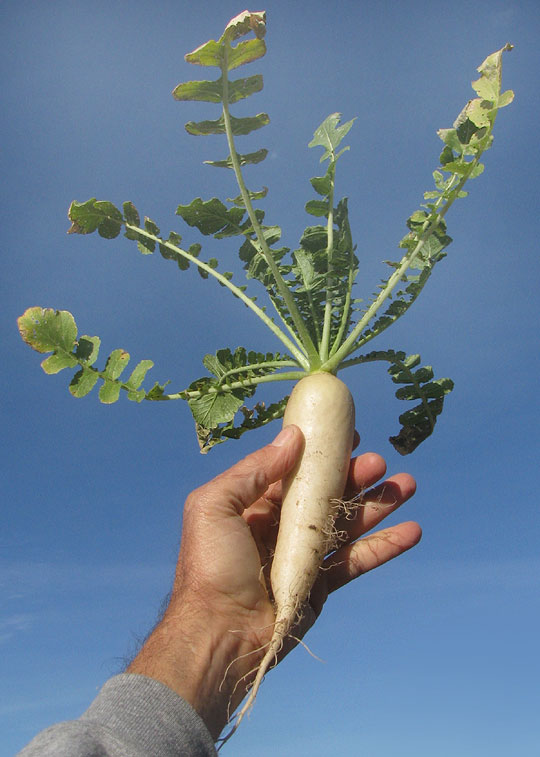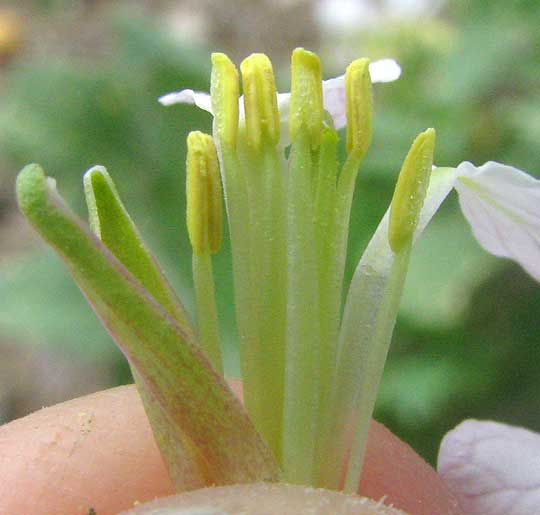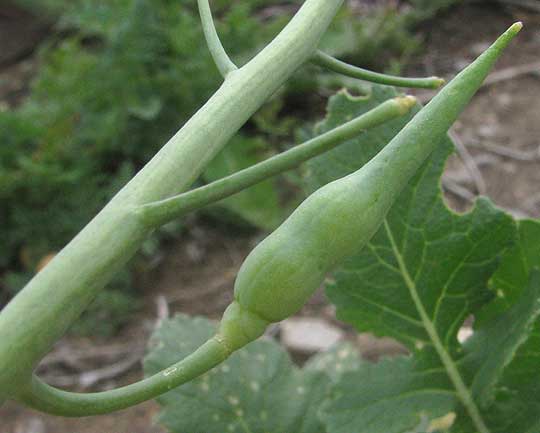Excerpts from Jim Conrad's
Naturalist Newsletter
from the December 30, 2012 Newsletter issued from the valley of the Dry Frio River in northern Uvalde County, southwestern Texas, on the southern border of the Edwards Plateau; elevation ~1750m (~5750 ft); N29.62°, W99.86°; USA
JAPANESE RADISH/ DAIKON
When I arrived here in late August I wanted to plant a winter garden but I'd brought only turnip and mustard greens seeds from Mississippi. My host had a package of seeds of Japanese Radish, which I'd never grown or eaten, but I planted them just to see what would happen.
The plants thrived, producing lovely dark green, pinnate leaves, and after a few weeks a white little taproot developed beneath the leaves and that was the future radish. These were tough plants, not wilting when southwestern Texas's hot, dry September winds blew, and they didn't develop the leaf diseases that some other crops did. I don't particularly like the taste of radishes but when I needed the raised bed for planting another crop I do like, those Japanese Radish plants looked so healthy and promising that I couldn't bear the thought of uprooting them.
For the last month or so the Japanese Radishes have been at the peak of perfection. You can see one plucked from the soil this Wednesday below:

Japanese Radish plants look much different from radish plants producing those small, spherical, red-top-and-white-bottomed, peppery tasting radishes most Americans think of as a radish. Not only is the taproot radically different but also the leaves. Leaves on "regular" radish plants are much shorter and bear only one to three pairs of leaf lobes, while Japanese Radish leaves produce eight to twelve pairs.
These conspicuous differences between "regular" radish plants and Japanese Radish plants make it a little surprising to learn that both radish types are the same species -- they're RAPHANUS SATIVUS -- just different varieties. Japanese Radish is Raphanus sativus var. longipinnatus. Some authorities refer to radishes of this variety as Chinese Radish, which might be more appropriate, since the cultivar originated in continental Asia and was introduced into Japan via China during the Han Dynasty, around 2000 years ago. I call it Japanese Radish only because that's what the seed package said, and it seems that that name is most used in the US. In the UK they may call it Mooli, and in the literature often it's referred to as Daikon, from the Japanese meaning "big root."
Japanese Radish taproots aren't nearly as peppery tasting as regular radishes. Their leaves can be steamed and used as greens, but they're not as tasty and pleasingly textured as turnip and mustard-greens leaves. I personally like them best shredded into salads and used as a garnish. Mixed with avocado they're especially good. In Asia they're commonly used in soups, pickled and stir fried. A typical dish from Bangladesh mixes finely grated root with fresh chili, coriander, flaked steamed fish, lime juice and salt, then is served alongside meals.
For me, Japanese Radishes are worth growing mainly because they're such handsome, well behaved plants, just a pleasure to look at.
from the March 31, 2013 Newsletter issued from the Frio Canyon Nature Education Center in northern Uvalde County, southwestern Texas, on the southern border of the Edwards Plateau; elevation ~1750m (~5750 ft); N29.62°, W99.86°; USA
JAPANESE RADISH FLOWERING & FRUITING
Now that days are growing longer and warmer some of my radishes are bolting, issuing long racemes of white flowers that in some cases already are "going to fruit." You can see some flowers below:

Radishes are members of the Mustard Family, the Cruciferae, and that word Cruciferae is based on the Latin "crucifer" meaning "cross bearing," as is "crucifixion." You can see in the above picture that the Mustard Family's crosses being referred to are the four-petaled flowers. All Mustard-Family blossoms bear four petals, except in those species with no petals. That field mark helps us recognize members of this family. Many plant families produce flowers with three or five petals, or multiples of three or five, than four. Below you can see another diagnostic field mark of Mustard Family flowers:

There two petals have been removed so you can see the blossom's six stamens with their yellow, oblong, pollen-producing anthers atop their slender, greenish filaments. Notice that two stamens are shorter than the other four. It's like this throughout the big Mustard Family, so when you see a flower with four petals and six stamens of which two are shorter than the others, a good bet is that you have a member of the Mustard Family. By the way, flowers bearing four long stamens and two shorter ones are said to be "tetradynamous."
Mustard Family members also produce fairly distinctive pod-type fruits. Pod fruits are just those that split apart to release seeds when the fruits dry out. In the Mustard Family when the pod is longer than broad it's called a "silique," but when it's as broad as long it's a "silicle." Below you can see the Japanese Radish's silique-type fruit with its outlandishly long, nose-like "beak" and the constrictions between its unusually large seeds -- two seeds in this pod:

Behind the silique in that picture you see the stems, or pedicels, of flowers that have fallen off, having produced no fruits. I'm guessing that those flowers aborted because during the cold days of their flowering they didn't get pollinated. Farther up the raceme where flowering occurred during warmer, more recent days, every flower is setting fruit.
Radish siliques are exceptional in the Mustard Family in that they do not split open to release seeds when mature.